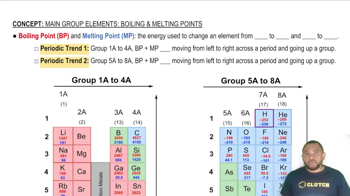Suppose you were dissatisfied with both Celsius and Fahrenheit units and wanted to design your own temperature scale based on ethyl alcohol (ethanol). On the Celsius scale, ethanol has a melting point of -117.3 °C and a boiling point of 78.5 °C, but on your new scale calibrated in units of degrees ethanol, °E, you define ethanol to melt at 0 °E and boil at 200 °E. (c) What are the melting and boiling points of water on the ethanol scale?
Sodium chloride has a melting point of 1074 K and a boil-ing point of 1686 K. Convert these temperatures to degrees Celsius and to degrees Fahrenheit.

Verified Solution
Key Concepts
Temperature Conversion

Melting and Boiling Points

Phase Changes

Suppose you were dissatisfied with both Celsius and Fahrenheit units and wanted to design your own temperature scale based on ethyl alcohol (ethanol). On the Celsius scale, ethanol has a melting point of -117.3 °C and a boiling point of 78.5 °C, but on your new scale calibrated in units of degrees ethanol, °E, you define ethanol to melt at 0 °E and boil at 200 °E. (d) What is normal human body temperature (98.6 °F) on the ethanol scale?
Suppose you were dissatisfied with both Celsius and Fahrenheit units and wanted to design your own temperature scale based on ethyl alcohol (ethanol). On the Celsius scale, ethanol has a melting point of -117.3 °C and a boiling point of 78.5 °C, but on your new scale calibrated in units of degrees ethanol, °E, you define ethanol to melt at 0 °E and boil at 200 °E. (e) If the outside thermometer reads 130 °E, how would you dress to go out?
